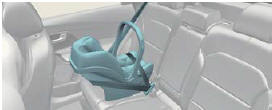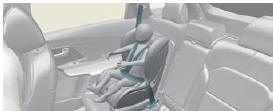Kia Sportage: Selecting a CRS
When selecting a CRS for your child, always:
- Make sure the CRS has a label certifying that it meets applicable Federal Motor Vehicle Safety Standards (FMVSS 213).
- Select a child restraint based on your child's height and weight. The required label or the instructions for use typically provide this information.
- Select a child restraint that fits the vehicle seating position where it will be used.
- Read and comply with the warnings and instructions for installation and use provided with the CRS.
WARNING
Holding children
Never hold a child in your arms or lap when riding in a vehicle. The violent forces created during a crash will tear the child from your arms and throw the child against the car's interior. Always use a Child Restraint System which is appropriate for your child's height and weight.
WARNING
Unattended children
Never leave children unattended in a vehicle. The car can heat up very quickly, resulting in injuries to the child in the vehicle.
WARNING
Seat belt use
Do not use one seat belt for two occupants at the same time. This will eliminate any safety benefit provided by the seat belt to the occupants.
CRS types
There are three main types of the CRS: rear-facing seats, forward-facing seats, and booster seats. They are classified according to the child's age, height and weight.
Rear-facing child seats
 A rear-facing
child seat provides
restraint with the seating surface against
the back of the child. The harness system
holds the child in place, and in an
accident, acts to keep the child positioned
in the seat and reduces the stress
to the neck and spinal cord.
A rear-facing
child seat provides
restraint with the seating surface against
the back of the child. The harness system
holds the child in place, and in an
accident, acts to keep the child positioned
in the seat and reduces the stress
to the neck and spinal cord.
All children under age one must always ride in a rear-facing infant child restraint.
Convertible and 3-in-1 child seats typically have higher height and weight limits for the rear-facing position, allowing you to keep your child rear-facing for a longer period of time.
Continue to use a rear-facing child seat for as long as your child will fit within the height and weight limits allowed by the child seat manufacturer. It's the best way to keep them safe. Once your child has outgrown the rear-facing child restraint, your child is ready for a forward-facing child restraint with a harness.
Forward-facing child restraints
 A forward-facing child seat
provides
restraint for the child's body with a harness.
A forward-facing child seat
provides
restraint for the child's body with a harness.
Keep children in a forward-facing child seat with a harness until they reach the top height or weight limit allowed by your child restraint's manufacturer.
Once your child outgrows the forwardfacing child restraint, your child is ready for a booster seat.
Booster seats
A booster seat is a restraint designed to improve the fit of the vehicle's seat belt system. A booster seat positions the seat belt so that it fits properly over the lap of your child.
Keep your child in a booster seat until they are big enough to sit in the seat without a booster and still have the seat belt fit properly. For a seat belt to fit properly, the lap belt must lie snugly across the upper thighs, not the stomach.
The shoulder belt should lie snug across the shoulder and chest and not across the neck or face. Children under age 13 must always ride in the rear seats and must always be properly restrained to minimize the risk of injury.
READ NEXT:
 Installing a CRS
Installing a CRS
After selecting a proper child seat for
your child, check to make sure it fits
properly in your vehicle.
Follow the instructions provided by the
manufacturer when installing the child
seat. Not
 Securing a child restraint with the
LATCH anchors system
Securing a child restraint with the
LATCH anchors system
To install a LATCH-compatible child
restraint in either of the rear outboard
seating positions:
Move the seat belt buckle away from
the lower anchors. Otherwise, the
webbing or buckle can be
 Securing a child restraint with a
lap/shoulder belt
Securing a child restraint with a
lap/shoulder belt
When not using the LATCH system, all
child restraints must be secured to a
vehicle rear seat with the lap part of a
lap/shoulder belt.
Automatic locking mode
All passenger seat belts move
freel
SEE MORE:
 Surround View Monitor malfunction and limitations
Surround View Monitor malfunction and limitations
Surround View Monitor malfunction
When Surround View Monitor is not
working properly, or the screen flickers,
or the camera image does not display
normally, have the vehicle inspected by
an authorized Kia dealer.
Limitations of Surround View Monitor
The screen may be displayed abnormally,
an
 Starter
Starter
Components and Components Location
Components
Front housing
Starter solenoid assembly
Lever
Lever packing
Planet shaft assembly
Planetary gear assembly
Packing
Shield
Amature assembly
Brush holder assembly
Yoke assembly
Rear housing
Through bolt
Repair procedu
Content
- Home
- Kia Sportage - Fifth generation (NQ5) - (2022-2025) - Owner's Manual
- Kia Sportage - Second generation (JEKM) (2005-2015) - Body Workshop Manual
- Kia Sportage Third generation (SL) - (2011-2016) - Service and Repair Manual
- Sitemap
- Top articles